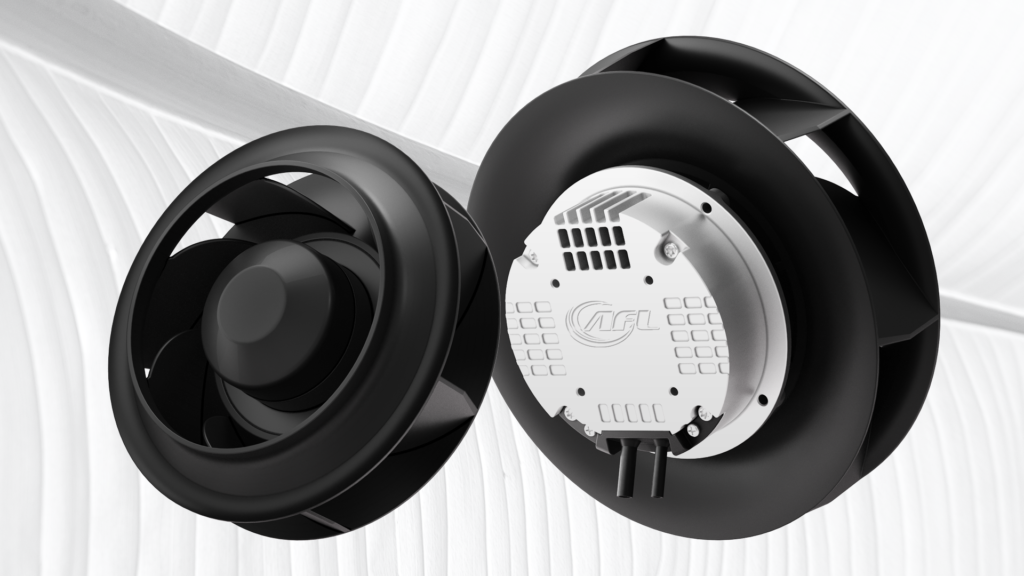Less than 10 years ago, EC technology was a novelty in the industry and it wasn’t entirely clear whether it is the future or just a temporary fad. Today, electronically commutated motor technology has become a permanent fixture in the HVAC industry and others. These types of motors are already used in all models and sizes of fans. Manufacturers and customers have long since learned about the benefits of using EC fans, which is why air conditioning and ventilation units with AC fans are basically no longer available on the market. EC fans are most often chosen by manufacturers also in terms of other products such as recuperators, heat pumps, filtration devices, humidifiers, door curtains, etc.

EC motor construction
An EC motor is a combination of the advantages of AC and DC motors, so that the newly created design includes all the advantages of both of these solutions. It's a motor with electronic commutation which is basically powered by alternating current (AC), but is actually more similar to a direct current (DC) motor. It is a brushless DC electric motor; hence it can also be found under the name BLDC. EC motors take advantage of permanent magnets and electric windings to generate magnetic fields, similarly to brushed DC motors. However, as their name suggests, they achieve commutation electronically. This is possible thanks to the electronics built into the motor housing, including a rectifier which converts the AC power to DC. The integrated controller then directs the correct amount of current in the right direction and at the right time through each of the windings. This results in creating magnetic poles in the stator which interact with the permanent magnets in the rotor.
Advantages of EC motors
EC technology is a smart and advanced electric motor control technique. The built-in and miniaturised electronic control systemseliminate losses due to engine slippage and ensure engine operation in the optimal speed range. Compared to a traditional motor, there are no copper and iron losses during the operation of an electronically commutated motor, which is why the motor can achieve a capacity of up to 90%. What is very important is that, also when adjusting the engine rotary speed, high capacity is maintained. The rotational speed can be reduced to 20% of the full speed, while maintaining 85% capacity. For comparison, the capacity of a conventional motor ranges from 15 to a maximum of 50%. Another advantage of EC motors is that theydo not cause interference to the network, because the electronics contain EMC filters, power filters, and integrated motor protection. In AC fans, it was necessary to use additional filters limiting the interference to other devices.
EC fan adjustment
Thanks to the built-in electronics, it is also possible to smoothly adjust the rotational speed throughout the entire range by using simple controllers or sensors which produce a 0-10V, PWM, or 4-20mA signal. Such a solution eliminates the need to use external regulators, which often have an adverse impact on the motor winding and shorten its service life. There are open and closed loop control methods which can be implemented, depending on the demand. Fans with electronically commutated EC motors can control temperature, pressure, or any other parameter selected for measurement. Constant pressure control is particularly useful in duct applications, whereas constant airflow control is perfect for ventilation applications. Alternatively, a potentiometer can be connected to provide a manual form of variable speed control.
Advantages of EC fans
The high capacity mentioned earlier, low heat emission, and limited losses ensure a motor's long service life with minimal risk of overheating. This also results in that these are very energy-efficient fans, and nowadays it's a must, because lower energy consumption means less CO2 emissions2 into the atmosphere, as well as lower operating costs.Another advantage is their tight design and compact size compared to AC motors of similar power. This results in that the devices in which this type of fan is to be used can be smaller and more compact.
EC fans also provide a better operatingculture in terms of acoustics.Their sole design results in that the noise level, compared to AC motors, is much lower. Additionally, thanks to the possibility of smooth adjustment, it is also possible to further reduce the emitted noise and adjust the fan speed to the current needs. Fans with EC motors also offer unlimited possibilities of controlling, adjusting, and monitoring the operating parameter The built-in control system allows to measure rotational speed using potentiometers or various types of sensors. It is also possible to change the fan controller software to adjust the operating parameters to the needs of a given device.
The list of advantages of EC fans is long and undoubtedly makes them the only correct choice to be used in the HVAC industry in the near future.
The advantages of EC fans are as follows:
-
High capacity
-
Energy-efficient in the full range of speed control
-
Compact size
-
Smooth capacity adjustment
-
Reliability and long service life
-
Reliability and long service life
-
Easy control with the use of controllers and sensors with 0-10V/PWM signal
-
Complete control of the operating parameters

